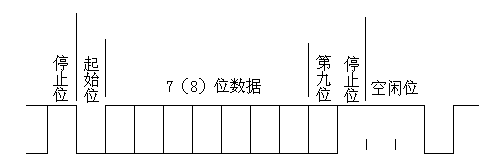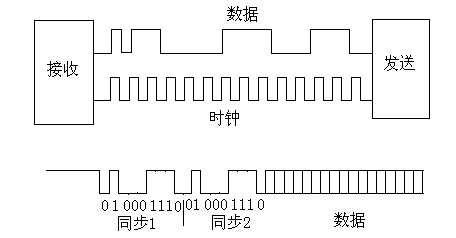During the network communication process, the two communicating parties need to exchange data and require a high degree of coordinated work. In order to correctly interpret the signals, the receiving party must know exactly when to receive and process the signals, so timing is of vital importance. In a computer network, the factor of timing is called bit synchronization. Synchronization means that the receiving party should receive the data according to the start and end moments and the rate of each bit sent by the sending party. Otherwise, errors will occur. Usually, synchronous or asynchronous transmission methods can be adopted to perform synchronization processing on the bits.
1.1 Asynchronous Transmission
Asynchronous transmission sends bits in groups. The group can be a single character of 8 bits or even longer. The sender can send these groups of bits at any moment, and the receiver has no idea when they will arrive. A common example is the communication between a computer keyboard and the host. When a letter key, a number key or a special character key is pressed, an 8-bit ASCII code is sent. The keyboard can send the code at any moment, which depends on the user's input speed. The internal hardware must be able to receive a typed character at any time.
There is a potential problem with asynchronous transmission, that is, the receiver doesn't know when the data will arrive. Before it detects the data and responds, the first bit has already passed. It's like someone suddenly comes up and talks to you from behind, and you don't have time to react, missing the first few words. Therefore, each piece of information transmitted asynchronously starts with a start bit, which notifies the receiver that the data has arrived. This gives the receiver time to respond, receive and buffer the data bits. At the end of the transmission, a stop bit indicates the termination of the transmitted information. As a convention, an idle (no data being transmitted) line actually carries a signal representing binary 1. The start bit of asynchronous transmission changes the signal to 0, and other bits make the signal change according to the transmitted data information. Finally, the stop bit changes the signal back to 1, and this signal remains until the next start bit arrives. For example, when the number "1" is pressed on the keyboard, according to the extended ASCII code of 8 bits, "00110001" will be sent, and a start bit needs to be added in front of the 8 bits and a stop bit at the back.

Asynchronous transmission is relatively easy to implement. Since each piece of information is added with "synchronization" information, the drift of timing will not lead to a large accumulation. However, it generates more overhead. In the above example, for every 8 bits, two additional bits need to be transmitted, increasing the total transmission load by 25%. For low-speed devices with a small amount of data transmission, this is not a big problem. But for those high-speed devices with a large amount of data transmission, a 25% increase in the load is quite significant. Therefore, asynchronous transmission is often used for low-speed devices.
1.2 Synchronous Transmission
The bit groups in synchronous transmission are much larger. Instead of sending each character independently, where each character has its own start bit and stop bit, they are combined and sent together. We call these combinations data frames, or simply frames.
The first part of a data frame contains a set of synchronization characters, which is a unique combination of bits. Similar to the start bit mentioned earlier, it is used to notify the receiving party that a frame has arrived. At the same time, it can also ensure that the sampling speed of the receiving party is consistent with the arrival speed of the bits, enabling the sending and receiving parties to enter a synchronized state.
The last part of the frame is a frame end marker. Just like the synchronization characters, it is also a unique string of bits. Similar to the stop bit mentioned earlier, it is used to indicate that there is no other data arriving before the start of the next frame.

Synchronous transmission is usually much faster than asynchronous transmission. The receiving party doesn't have to perform the operations of starting and stopping for each character. Once the frame synchronization characters are detected, it will receive the subsequent data as they arrive. In addition, the overhead of synchronous transmission is relatively small. For example, a typical frame may contain 500 bytes (i.e., 4000 bits) of data, among which there may only be 100 bits of overhead. At this time, the added bits increase the total number of transmitted bits by 2.5%, which is much smaller than the 25% increase in asynchronous transmission. As the number of actual data bits in the data frame increases, the percentage of overhead bits will decrease accordingly. However, the longer the data bits are, the larger the buffer required to cache the data will be, which limits the size of a frame. Moreover, the larger the frame is, the longer the continuous time it occupies the transmission medium. In extreme cases, this will cause other users to wait too long. In the synchronous transmission mode, the clocks of the sender and the receiver are unified, and the transmission between characters is synchronous and without intervals.
In the asynchronous transmission mode, it is not required that the clocks of the sender and the receiver are exactly the same, and the transmission between characters is asynchronous.
1.3 Differences between Synchronous and Asynchronous Transmission
● Asynchronous transmission is character-oriented, while synchronous transmission is bit-oriented.
● The unit of asynchronous transmission is a character, whereas the unit of synchronous transmission is a frame.
● Asynchronous transmission seizes the opportunity for resynchronization through the start and stop codes at the beginning and end of a character, while synchronous transmission extracts synchronization information from the data.
● Asynchronous transmission has relatively low requirements for timing, and synchronous transmission often coordinates the timing through specific clock lines.
● Asynchronous transmission is less efficient compared to synchronous transmission.




